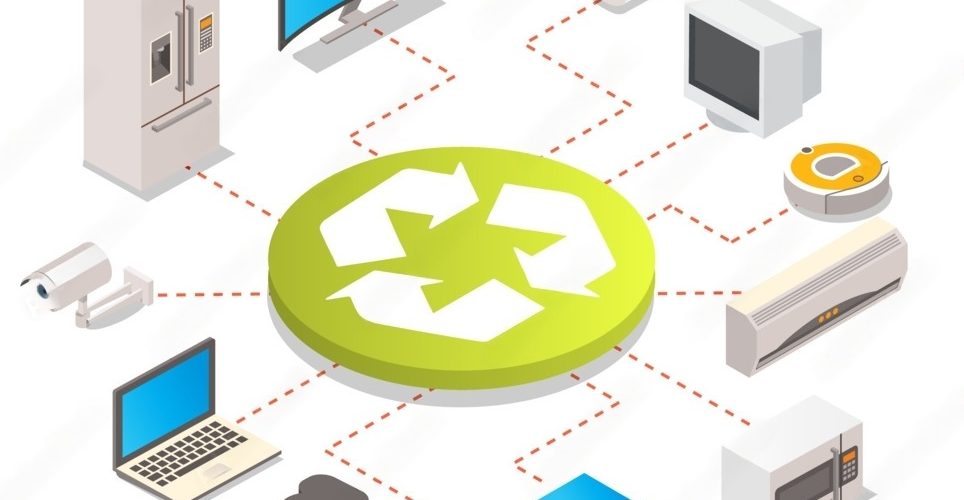The current digital era demands the adoption of e-waste recycling guidelines to ensure its future sustainability. Where technology continually advances, the issue of electronic waste, commonly referred to as “e-waste,” has become a notable concern. Governments globally are addressing environmental and resource concerns by establishing clear rules for e-waste recycling. This guide aims to simplify these rules for a broad audience, including both technology enthusiasts and high school students.
Understanding E-Waste Recycling Guidelines
Aggregation and Categorization:
E-waste recycling starts by collecting old electronic devices. Local authorities set up collection centers or campaigns where people can easily drop off their outdated gadgets. After collection, the next crucial step involves sorting the e-waste into different categories to handle each type of device appropriately.
Secure Conveyance and Logistics:
Once old gadgets are dropped off, the next step is to transport them securely to specialized recycling facilities. This requires careful handling to avoid releasing harmful materials during transit. Following Electronics waste recycling guidelines ensures a careful approach, minimizing environmental impact at every stage.
Ecologically Responsible Recycling Methods:
Effective e-waste management involves using environmentally friendly recycling methods. This includes taking electronic devices apart systematically to extract valuable materials like metals and plastics. At the same time, hazardous components are treated and disposed of responsibly to prevent pollution and protect ecosystems.
Data Security Protocols:
Recognizing the sensitive information stored in electronic devices, e-waste recycling guidelines emphasize the importance of data security. Recycling facilities must follow strict protocols to erase data securely before starting the recycling process, ensuring individual privacy is protected.
Public Awareness and Educational Endeavors:
Governments and environmental groups assume a vital role in amplifying awareness regarding the significance of recycling e-waste. Educational campaigns are designed to enlighten the public about the environmental repercussions of e-waste, illustrating how adherence to recycling guidelines actively fosters a sustainable future.
Impact of Following E-Waste Recycling Guidelines
Ecological Preservation:
Adhering to e-waste recycling guidelines helps prevent harmful substances from entering the environment. This preserves ecosystems and significantly reduces pollution, promoting overall planetary health.
Resource Retrieval and Conservation:
Recycling e-waste allows the recovery and reuse of valuable resources like metals and plastics, reducing the need for new raw materials. This fosters resource conservation and sustainable practices.
Economic Advantages and Job Creation:
Following e-waste recycling guidelines not only benefits the environment but also stimulates economic growth. The e-waste recycling industry creates job opportunities across various stages, from collection and transportation to processing and refurbishing.
Energy Efficiency:
Sustainable practices recommended by e-waste recycling guidelines lead to a significant reduction in energy consumption compared to manufacturing new electronic devices from raw materials.
In conclusion, e-waste recycling guidelines aim to reduce the environmental impact of our digital lifestyle. By understanding and participating in these guidelines, individuals become essential contributors to a global effort for a greener, more sustainable future. Bear in mind that the act of recycling antiquated gadgets transcends mere decluttering; it represents a collaborative endeavor to construct a more robust and healthier planet for the well-being of future generations.

Frequently Asked Questions on E-waste
-
Q: Why should I bother recycling my outdated electronic devices?
A: Recycling is not just about decluttering; it is a significant contribution to a collaborative effort aimed at building a more robust and healthier planet for the well-being of future generations.
-
Q: Can I recycle any electronic device, regardless of its condition?
A: Indeed, the majority of electronic devices are recyclable, although certain types may necessitate specialized facilities.
-
Q: How can I ensure my data is securely deleted before recycling?
A: Choose recycling facilities following data security protocols outlined in e-waste recycling guidelines, employing certified data erasure methods.
-
Q: Is e-waste recycling economically viable?
A: Yes, it not only benefits the environment but also creates jobs and recovers valuable materials, contributing to economic growth.
-
Q: Can I throw old electronics in regular trash bins?
A: It’s not recommended due to hazardous materials. Follow local regulations and use designated e-waste collection points.
-
Q: What happens to my old gadgets after dropping them off at a collection center?
A: E-waste is transported to recycling facilities where it undergoes processes like dismantling, material extraction, and secure data deletion before being repurposed or reused.
-
Q: How can I contribute to e-waste recycling personally?
A: Start by responsibly disposing of old electronic devices at designated collection points. Stay informed about e-waste recycling guidelines and spread awareness in your community to encourage others to do the same.

